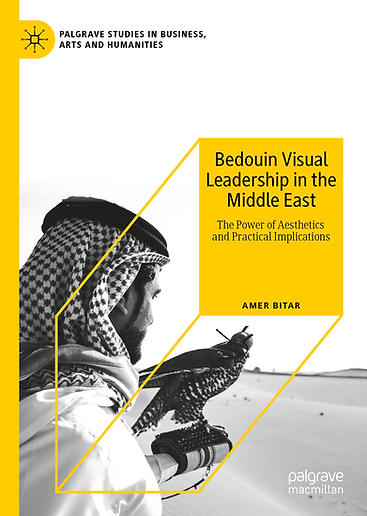Bedouin Visual Leadership in the Middle East: The Power of Aesthetics and Practical Implications
-
Explores the use of public images and their use in leadership
-
Includes interviews with artists of public images, providing an overview of the context
-
Charts a practical path to maximizing the effectiveness of visual messages.
BUY THIS BOOK

MORE ABOUT BOOK
This book focuses on leadership as a visual discourse and explores the construction of this discourse within the context of Bedouin Arabia, and the Middle East more broadly. In it, the author considers business and organizational leadership from an aesthetic perspective and in the context of various geographical and historical settings. The book examines the work of a variety of artists and examines how public representations of business and political figures are used as a tool of leadership.
Using a Foucauldian perspective, the book explores the interconnected concepts of power and knowledge, examining how visual images are used in the Middle Eastern context for leaders to communicate with their followers and the public. The Bedouin business world provides a unique opportunity for the researcher to examine the interplay between culture, management and politics. The book will be of interest to academics working in the fields of aesthetics, leadership, management, culture, and the Middle East more broadly.
Chapter 1: Visualizing Leadership in Bedouin Arabia
In Chapter 1, I present the topic of study, clarify the terminology (including such fundamental concepts as Arab, Arabic, Arabia, Muslim, and Orient), and describe the philosophical perspective, particularly with respect to Foucauldian analysis, and the methodology. In the process, I explain my approach to leadership as a socially constructed phenomenon and the theoretical framework for the book. This introductory chapter also provides an overview of the relevant academic literature on leadership, the ontological foundation of the research and the power of visual messages.
Chapter 2: Overview of Visual Leadership Studies
The focus in Chapter 2 is on the academic approaches to visual leadership; thus, I evaluate the progress that has been made in the study of visual leadership and reflect on the insights revealed by this research and its future directions. I survey scholarship that has been influential in the development of this field, including work in such related fields as visual and cultural studies. I also in this context elaborate on the notions of propaganda and metaphor that have played significant roles in the development of this field. The aim is to provide a holistic sense of visual leadership.
Chapter 3: Bedouin Culture
In Chapter 3, I describe Bedouin culture in some detail with an emphasis on the visual representation of leadership. Also, I discuss the core characteristics of Bedouin culture that relate to visual leadership. I provide a few examples of leaders from the region who have presented themselves in the trappings of Bedouin culture. Their leadership in this respect is especially evident in their appearance in traditional garb.
Chapter 4: The Leader’s Perspective
The focus in Chapter 4 is on the visual discourse of leadership, with publicly displayed images of Sheikh Mohammed bin Rashid al Maktoum, the Bedouin leader of Dubai, serving as a case study. The analysis presented here is based on the first phase of the empirical research that I conducted for this project. More specifically, I describe the point of view established by a select set of official representations of Dubai’s leading business and political figures.
Chapter 5: The Artist’s Voice
In Chapter 5, I explore the creation of visual images by presenting the results of semi-structured, in-depth interviews with eight Arab artists. These interviews provide a nuanced picture of the communication process, including the context and the content of leadership messages. I draw attention to the social, cultural, and historical dimensions of these artists’ work in order to arrive at insights into their notions of leadership, power, authority, discourse, surveillance, heroism, and gaze.
I purposely selected artists from diverse backgrounds for the interviews. The interview questions concerned the artist’s subjects, what they aimed to achieve through their art, their representation of leadership, the concept of power, and the influence of Bedouin society on their paintings.
Chapter 6: The Audience’s Perspective
In Chapter 6, the focus is on the audience for and the reception of messages relating to leadership encoded in images. For this third phase of my empirical research into the visual aspects of leadership and audiences’ interpretations of messages, I presented three of the images of Sheikh Mohammed discussed in Chapter 4 to ten residents of Dubai of various nationalities and cultural backgrounds. The chapter, then, explores their assessments of these images
Chapter 7: The Power of Aesthetics
The concluding chapter provides an overview of the findings from the perspectives on leadership established in the previous chapters. Thus, the discussion addresses issues relating to the leaders who send visual messages, the artists who create such messages, and the audiences targeted by these messages. The topics explored include the power of symbols, images, and aesthetics, and particular attention is paid to the potential for a leader’s images to function as a kind of surveillance apparatus, specifically, the panopticon that is a central theme in Foucault’s work and the practical implications for leadership in the Bedouin business context.



